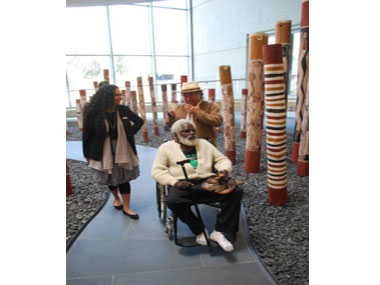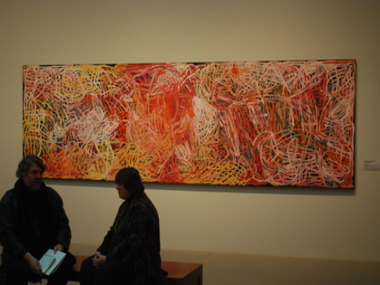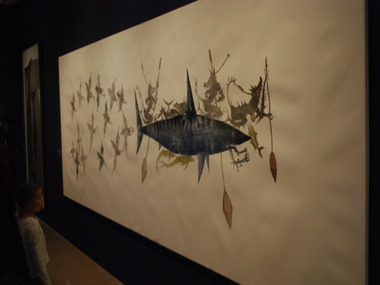NEW PARADIGM IN CANBERRA

Franchesca Cubillo, Djon Mundine and artist Richard Birrinbirrin, who sang the Ramingining poles into their new gallery home
Posted by Jeremy Eccles | 03.10.10
Dates:
01.10.10
Prototype, precedent, templet, archetype, scantling, paradigm...so reads my Roget's Thesaurus – which I think gives you the drift of my thinking regarding the importance of recent events in Canberra.
No – not on the Hill, where Tony Abbott seems determined not to permit a new paradigm to come into being. But at the National Gallery of Australia (NGA) where, 28 years after the grand lakeside building opened, a huge extension offers dedicated space for Aboriginal art for the first time. Weird to think that galleries for indigenous art weren't considered necessary when the NGA was planned as recently as 40 years ago!
Now this art is pioneering breaches in another piece of blinkered thinking back then – they use natural light for art that was conceived in the brilliance of Australia's luminescence; first for the 11 new indigenous galleries, and then, in Stage 2 of Director Ron Radford's grand plans, for the rest of Aussie art. That still leaves plenty of room in the majestic old galleries for the clouded output of Europe and America, not forgetting the exhilarating bewitchery of the current South-East Asian show (Life, Death & Magic), which revels in its pre-electric presentation...a world of goolies and ghosties!
Those 11 new galleries house 600 artworks – a fabulous feast of indigeneity offering, in Senior Curator Franchesca Cubillo's words, “so many entry points for people...enjoyable, provocative, even painful”. What's definitely not painful is the recognition by Ron Radford that this is the art that so many people want to see first when they hit a state gallery. For now the NGA has an entrance at ground level. And when you walk in, you're confronted by The Aboriginal Memorial in a special space of its own – the 200 lorrkons or bone coffins that Ramingining artists created to take the edge off white Australia's Bicentenary celebrations. Why set them in granite pebbles rather than Arnhemland sand? And why did I get the feeling that the domed roof was conceived by someone with a war memorial in mind?
Upstairs, the provocation continues as you're greeted by the juxtaposition of the multi-panelled Alhalkere Suite from Emily Kngwarreye's wild Colourist period with Fiona Foley's bold Dispersed – a euphemism for massacred – in darkly gleaming 3D letters and bullets. A celebration of country beside a critique of nation!
We're then taken through the significant eras and regions of indigenous art – from early barks (before the odd cut-off at 1980) and Hermannsburg water-colours, through the Torres Strait and The Kimberley, to a Desert divided into pre and post-1975 and Blak art from the cities.
It's a predictable reflection of the NGA's huge, 7500-strong collection. Their significant and record price-setting Emilys, Rovers and Clifford Possums are there, every prominent urban artist gets a look-in, and there's a fine collection of early Papunya boards. Wally Caruana's work as the curator who built the collection is proudly on show. But does this premiere hang equally reflect the entirety of “The last great art movement of the 20th Century”, which were Robert Hughes' words? For there's a significant hole in the post-1975 Desert display - the fruitful women of Utopia (apart from Emily) and the Anangu from the APY Lands who've forcefully joined the fray since 2000 and brought back memories of pioneering Papunya are almost entirely missing.
It's almost as if the planners who preceded Cubillo's arrival 15 months ago wanted to downplay the power and influence of the Deserts from which this art seemed to spring so insistently in 1971.
Or did it?? For quietly tucked away amongst this panoply of art is a Nym Banduk canvas from 1959. This Port Keats man clearly knew how to serve up his traditional iconography as “art” in a Western sense 13 years before Geoffrey Bardon arrived in Papunya. And who's to say that Long Jack Phillipus wasn't offering us a work that was primarily decorative in his 1972 Water Dreaming? And how did Holder Adams Punguatji get away with such a wildly original Pukumani pole in Milikapiti in 1984? And who knew that Oodgeroo Noonuccle made beautiful textile art as well as beautiful poetry?
There are some fascinating questions tucked away amongst absolutely unsurpassed artworks by Micky of Ulladulla, Dennis Nona, Gulumbu Yunupingu, Daniel Walbidi and Hector Jandany. For instance, I was asked by a visiting arts writer why Rover Thomas might have painted Cyclone Tracy? Since the answer helps to explain the genesis of the whole East Kimberley art movement, this raises the fraught issue of whether artwork captions ought to offer a whole lot more than the artist's name and the work's title?
Over at the National Museum, the sensational Canning Stock Route show does this didactic job brilliantly. Downstairs at the NGA, Life, Death and Magic offered a feast of reading for the mind. But the official line from Franchesca Cubillo – who comes from a museological background and rejects the idea of separating her people's art from its cultural context - is that she wants to offer only visual stimulation: “The complex stories behind the individual artists, their works and their regions are better left to our fabulous book on the indigenous collection (currently suffering an unfortunate print delay) and the I-pads in the resource room. We're also developing podcasts and wi-fi in all the galleries” - which may well provide a complete answer to this low-tech maiden's prayer.
I look forward to trying them out on future visits to the NGA – for this hang will only survive 3 months. Next year will also challenge us with the second National Indigenous Art Triennial – and, significantly, it won't take space in the 11 new permanent galleries, but take over yet more of the NGA.
URL: www.nga.gov.au
Share this:
»  del.icio.us
»
del.icio.us
»  Digg it
»
Digg it
»  reddit
»
reddit
»  Google
»
Google
»  StumbleUpon
»
StumbleUpon
»  Technorati
»
Technorati
»  Facebook
Facebook
Contact Details
Gallery: National Gallery of Australia
Contact: Tina Baum - Curator Aboriginal and Torres Strait Islander Art
Telephone: +61 2 6240 6502
Address: Parkes Place or GPO Box 1150 Canberra ACT 2601 Parkes Parkes 2601 ACT

Emily Kngwarreye's Yam Awelye, 1995, challengingly hung the other way up to its last appearance at the Emily Retrospective in 2008

A youthful viewer is entranced by Dennis Nona's legendary shark.
Further Research
Artists: Daniel Walbidi | Dennis Nona | Emily Kngwarreye | Fiona Foley | Gulumbu Yunupingu | Hector Jandany | Holder Adams Punguatji | Long Jack Phillipus | Micky Of Ulladulla | Nym Banduk | Oodgeroo Noonuccle | Richard Birrinbirrin | Rover Thomas
News Tags: Franchesca Cubillo | National Gallery | Ron Radford
Exhibition Archive
- 10.10.17 | TARNANTHI 2017
- 11.08.17 | Natsiaas 2017
- 20.07.17 | APY ART DOMINATES THE WYNNE
- 17.07.17 | Anangu Artist Wins $100,000 Prize
- 14.07.17 | The End of AAMU
- 11.07.17 | ART ACROSS THE COUNTRY
- 11.07.17 | TARNANTHI IN OCTOBER
- 05.07.17 | TJUNGUṈUTJA - from having come together
- 13.06.17 | Ghost-Nets Straddle the World
- 07.06.17 | Grayson Perry Going Indigenous?
- 05.06.17 | Barks Bigger than Ben Hur
- 27.05.17 | NGA QUINQUENNIAL 2017
- 21.05.17 | Blak Douglas Finds Home at the NGA
- 21.05.17 | BRIAN ROBINSON WINS HAZELHURST WOP
- 18.05.17 | PARRTJIMA 2.0
Advertising

